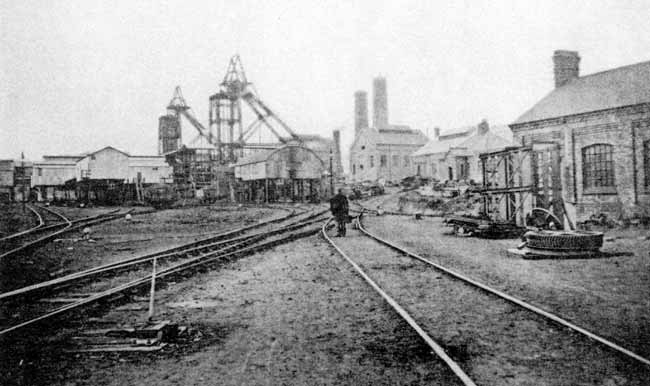< Previous | Contents | Next >
Geology of the District
GEDLING and Carlton are situated, geologically speaking, on the Trias or New Red Sandstone. This formation is well developed in Nottinghamshire, occupying indeed by far the greater part of the County, and is divided into an upper or Keuper Series and a lower or Bunter Series.
Only the Keuper division is exposed at the surface in the area under consideration, the villages of Gedling and Carlton lying on the lower division of the Keuper, commonly known as the Waterstones, while the upper division—the Keuper Marl—forms the higher ground surrounding the villages on all sides except that looking towards the valley of the Trent.
The Waterstones consist of alternations of red marl and greenish-grey sandstones, and are well seen in the brickyard at Carlton Hill. The Sandstones are frequently ripple-marked, and occasionally bear on their under surfaces pseudomorphs in sand after cubical crystals of common salt. The ripple marks were caused by the action of the wind on the surface of the water during the deposition of the sandy material, exactly as they may be seen in course of formation on any sandy shore at the present day. The salt pseudomorphs were formed on the shores of a very saline body of water. When the sandy or muddy surface was exposed to the air, the salt water evaporated and the salt crystals gradually formed in the hardening material. When the surface was again covered with water the salt crystals were dissolved, and on the deposition of further material the square hollows they occupied became filled with sand; and as the subsequent consolidation of the sand into sandstone the casts of these hollows projected from the under surface of the overlying stratum. Sun-cracks and worm-burrows have also been observed in these beds, and at Colwick the foot-print of a large reptile was discovered on a slab of sandstone. These features indicate that the beds containing them were deposited between high and low tide marks.
Sections of the Lower Keuper may be seen in road and railway cuttings at Gedling and Carlton.
The Keuper Marls consist of bright red marl or clay with occasional thin beds of hard sandstone (locally known as "skerries"), the latter often ripple-marked. Veins of gypsum are common in the marls, as may be seen in the cliff-section at Radcliffe-on-Trent. This division of the Keuper forms a thick capping to all the high ground around Gedling and Carlton, and is well exposed in the brickyards on Carlton Hill and on the Mapperley Plains. The marls are of considerable economic importance, yielding the familiar red bricks of the Nottingham district, while the gypsum industry is also an important one in Notts.
Owing to the impervious nature of the marls, the rain water falling on them does not readily sink in, but collects into streams which gradually work their way downwards until a hard bed of sandstone is reached, thus forming the picturesque narrow ravines known as "dumbles."
The Keuper beds in the parish of Stoke Bardolph are completely hidden beneath the Alluvial Deposits of the Trent valley.
The sinkings at the recently opened colliery at Gedling yield interesting information as to the strata below the surface.* The shafts commenced in the Lower Keuper, below which they entered the Bunter, the total thickness of the two divisions of the Trias being about 460 feet. About 47 feet of grey marls belonging to the Permian formation were next pierced, and the borings then entered the Coal Measures. These consisted of about 100 feet of red and mottled marls, identified by Dr. Walcot Gibson with the Etruria Marls (Upper Coal Measures) of North Staffordshire; followed by over 750 feet of ordinary grey and black Coal Measures, with numerous thin seams of coal, to a total depth of 1368 feet.
The difference in character between the Permian beds of the Gedling boring and the typical development of this formation at Bulwell and Kimberley is very remarkable. In place of the threefold division at these localities into the bright red Permian Marl, yellow crystalline Magnesian Limestone, and brown flaggy "Marl Slates" with a basal breccia 3 or 4 feet thick, we get at Gedling a series of light greyish marls quite undifferentiated except for a breccia 8 inches thick forming their base.
Two seams of Coal in the grey Coal Measures are worked; these occur at depths of about 1120 and 1368 feet, and are known respectively as the "High Hazles" and the "Top Hard."
Note.—Contributed by Professor J. W. Carr, M.A., F.G.S., of University College, Nottingham.
*See W. Gibson, Summary of Progress of the Geol. Survey for 1902. p. 13.
Early use of Gedling Stone
No doubt the Gedling quarries were worked, and Gedling stone used for building purposes, long before the date of any existing documentary reference, such as that in the "Borough Records."
Mr. E. Green's little History of Nottingham Castle, 1902, says the castle accounts for 1321-2 mention payments made of 2d. per day for getting stone at the quarry of Odelinge. Also that the accounts of 1366 refer to very extensive building and repairing operations at the castle, occupying altogether a hundred and four weeks, and costing a total of £384 4s. 0½d. The stone used was from Basford and Sedlyng.
In both the above cases, there can be no moral doubt that Gedling was the word written or intended.
Gedling Colliery

Gedling Colliery.
The late Rector of Gedling, in the parish magazine for January, 1881, after referring to an attempt he had made to revive the hosiery trade in the parish, stated:— "If, however, trade were really to revive and be brisk, by a great and permanent demand for iron, I think we should then stand some chance of seeing coal raised in the parish and iron works established amongst us, which would do more for the place than anything else. If I were a young man, and a trader instead of a minister of Christ, with a capital of two hundred thousand pounds, I would soon fetch the black diamond of Gedling to the surface; I know it is very deep, not much less than 500 yards beneath our feet, which is about as deep as nine Gedling spires piled one on the top of the other; but all the better for that, since what is little better than mere rubbish at Clifton, Wollaton, and Bestwood Collieries, because too near the surface, at Gedling pits would be first-class coal, and command the best price; and there are advantages which one particular pit in the parish of Gedling would possess (I am not going to tell the secret) which would give the coal owner pretty nearly the monopoly of supply in the town of Nottingham. Should the world last, (a circumstance I would not calculate upon) the day will come, when men will be found who shall say, 'Why there was a rector in Gedling not very long since, who said so and so, and his words have all come true.' I would ask intelligent young men amongst us, who look a little further before them than the ends of their noses, and believe that the business of man's life consists in something more than just pouring beer or spirits down their throats, and so degrading human nature, to remember these words of mine. I may be dead and buried before that day arrives, but Gedling Church spire will live to see more than one tall chimney lifting an ugly head aloft, and doing useful work in the parish—although the work they do will not be work that shall last as church work lasts, for that lives through the countless ages of eternity."
The venerable Rector's remarkable prediction was fulfilled more quickly than he anticipated, but he did not live to see the result. The Digby Colliery Company, Limited, has kindly supplied us with the following interesting particulars of their operations in the parish of Gedling:—
"Sinking was commenced in March, 1900, and the Top Hard seam of coal was found at a depth of 459 yards in September, 1902. The diameter of the shaft is 18 feet, and there is about 100 yards of metal tubbing fixed in the shaft to keep back the water from the water bearing strata. Two seams of coal are worked, namely :— the High Hazel, which is specially noted for its clean burning properties, and excessive heat. The Top Hard is very similar to that of the neighbouring collieries. The pits are fitted up with the most modern Engines, Steel Headgear, and up-to-date Screening Plant, capable of dealing with 3,000 tons of coal per day. The number of men and boys employed is 1,400."
